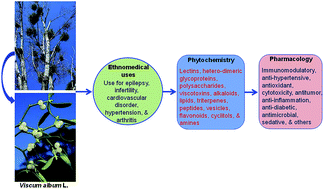European Viscum album: a potent phytotherapeutic agent with multifarious phytochemicals, pharmacological properties and clinical evidence
Abstract
Viscum album L. or European mistletoe (Loranthaceae), a semi-parasitic shrub, has been used as a traditional medicine in Europe for centuries to treat various diseases like cancer, cardiovascular disorder, epilepsy, infertility, hypertension and arthritis. V. album contains diverse phytochemicals, which exert a large number of biological and pharmacological activities. The aim of this review is to compile the developments in the domain of V. album and research trends, with a focus on ethnopharmacology, phytochemistry and pharmacological properties, to illustrate the potential of this phytotherapeutic as an attractive commercial herbal medicine. Crude extracts and isolated chemical constituents from V. album have exhibited significant medicinal effects in experimental models and in patients with cancer, autoimmune and inflammatory conditions. Importantly, recent randomized clinical trials have suggested improved overall survival and quality of life in cancer patients treated with different mistletoe preparations. The current phytochemical studies have shown that lectins, hetero-dimeric glycoproteins, polysaccharides, viscotoxins, alkaloids, lipids, triterpenes, peptides, vesicles, flavonoids, cyclitols and amines are principal bioactive phytochemicals of V. album. Clinical studies and experimental models have revealed that V. album exhibits several pharmacological functions such as immunomodulatory, anti-hypertensive, anti-oxidant, cytotoxicity, anti-tumor, anti-inflammation, anti-diabetic, anti-microbial and sedative activities. It is conceivable that the heterogenous profile of biochemical compounds provides the basis for the broad diversity of pharmacological activities of mistletoe, as each single component contributes diverse modes of action in addition to imparting a synergistic beneficial action in conjunction with other molecules.


 Please wait while we load your content...
Please wait while we load your content...